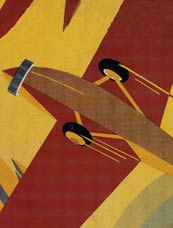|
SUNK!
This airplane is a Lockheed Vega 5 (S/N 55; ATC# 93)
manufactured in December, 1928 by the Lockheed Aircraft Corporation,
Burbank, CA. It left the factory with a Pratt & Whitney
Wasp engine of unidentified HP. It was a six-place airplane. Below, courtesy of Tim Kalina, is an undated photograph of NC658E.
Lockheed Vega NC658E, Pre-1930 (Source: Kalina)
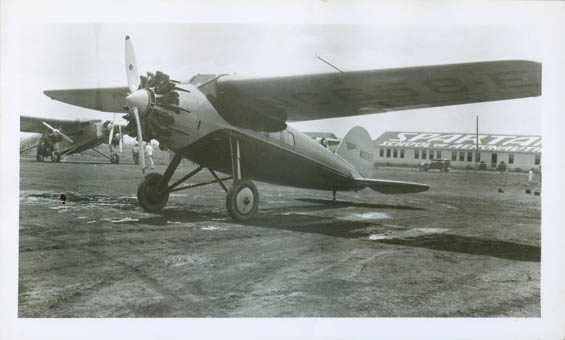 |
Mr. Kalina says about his photograph, "Judging by the Safeway Ford Trimotors in the background and the Vega itself I'd say this photo was taken early in the plane's flying life (when owned by Safeway). Note the early style bullet nose (no cowling as in the other photos [below]) and engine exhaust stacks." Below, the penciled annotation on the back of this photo.
Lockheed Vega NC658E, Pre-1930, Caption (Source: Kalina)
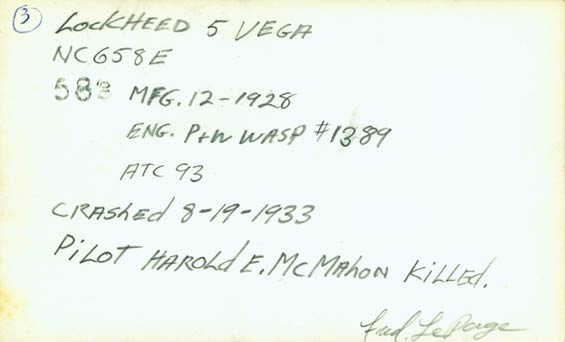 |
Below, again courtesy of Mr. Kalina, is another undated photograph. The woman standing in front is Elinor Smith (a Clover Field Register signer), well-known Golden Age pilot who flew endurance flights with Bobbi Trout.
Lockheed Vega NC658E, Ca. 1930 Location Unknown (Source: Kalina)
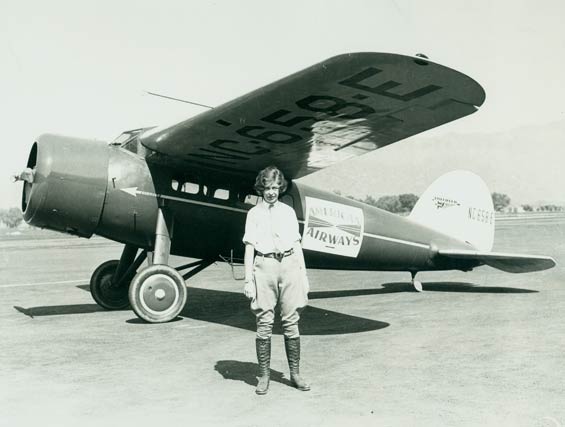 |
American Airlines Logo, 1934 (Source: Site Visitor)
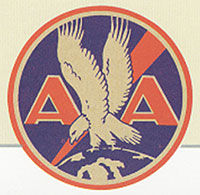 |
Mr. Kalina says about this photo, "The photo of NC658E is an old original and has written on the back 'Elinor Smith 1930'. This Vega was owned and operated by S.A.F.E.way Airlines, which was acquired by American Airways [AA]. This photo must have been taken shortly after AA acquired SAFEway but that sure isn't the standard AA Eagle logo on the fuselage." Notice, too, the installed engine cowling. The logo is the early AA symbol showing the navigation beacon beams fore and aft. Later, , in 1934 after American Airways had been reorganized as American Airlines, AA revised their logo with the only remaining artifact of the beacon being a single beam behind the eagle, right.
That the fuselage is painted with "American Airways" livery, suggests the photo might be dated 1930 when AA was in service (AA later became American Airlines). There is nothing in the NASM record (left sidebar) that places the aircraft with American Airways, however.
NC658E sold on May 29, 1929 to Erle Halliburton, Tulsa,
OK. Halliburton owned S.A.F.E.way Airlines. It suffered an accident at Sweetwater, TX on March
18, 1930. The pilot was Chester R. Bailes of Midland, TX with
two passengers. No injuries. It suffered "wing-tip broken,
left landing gear broken, #1 bulkhead cracked. $2,000 damage."
Below, courtesy of site visitor Bengt Eriksen, are three stills from a motion picture of the wrecked NC658E. You can see the clear damage to the left landing gear, and from the rear view in the second photo, the broken bulkhead is evident.
The Wreck of Lockheed Vega NC658E, March 18, 1930 (Source: Eriksen)
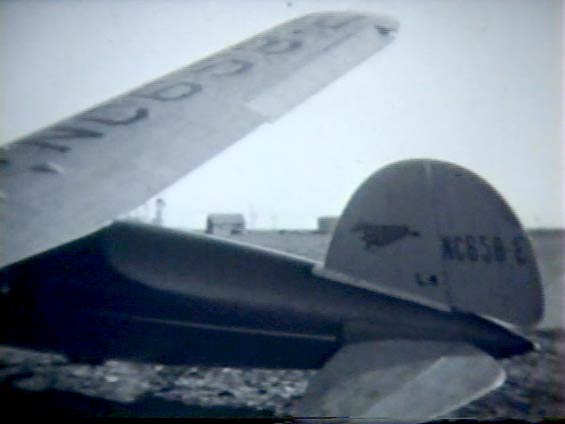 |
Note the bend in the fuselage, below.
The Wreck of Lockheed Vega NC658E, March 18, 1930 (Source: Eriksen)
 |
The Wreck of Lockheed Vega NC658E, March 18, 1930 (Source: Eriksen)
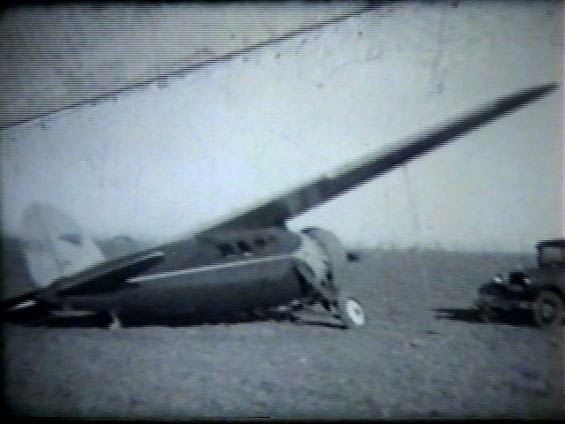 |
We find NC658E in Tucson one time on April 10, 1930
piloted by Bob
Cantwell. He was solo and westbound from Sweetwater,
TX to Los
Angeles. Given that his date of arrival was barely three weeks after the accident shown above, this could be a post-repair delivery or check-out
flight. On October 13, 1930 the airplane transferred from Halliburton to Cantwell's
employer, Southern Air Fast Express (SAFEway) Airlines.
S.A.F.E.way sold it to George A. Thorne on February 26, 1931.
It was rebuilt as a Vega 5C under ATC Gr. 2-385 as of August,
1931. As of May 19, 1932, the airplane was to make a foreign
flight and was cleared with the U.S. Department of State
for that purpose. The flight did not occur, however.
It suffered another accident at Saranac Inn, NY on July
15, 1932. It was repaired as of December, 1932. It was sold
on May 25, 1933 to Skyloft, Inc. of New York, NY. There was
yet another accident at Candler Field, Atlanta, GA. The airplane
was repaired.
Another accident on August 19, 1933 was not so simple.
NC658E crashed a final time in a tidal marsh three miles southeast of Leipsic,
DE. Pilot Harold E. McMahon was killed. The airplane sank.
Guest Editor Bob Woodling provides most of these articles. The Chester (PA) Times, Monday, August 21, 1933, reported as follows, left.
FLIER'S REMAINS
FOUND IN SWAMP
DOVER, Del., Aug. 21—Racing a tide, searchers yesterday recovered fragments of an airplane and part of a body, believed to be that of Harold E. McMahon, of Oyster [Bay?], N. Y., from a marsh on a farm near Leipsic, Del., five miles from here.
The plane buried itself in the mire Saturday after exploding in midair and crashing in flames, apparently
having been hit by lightning.
Farmers that saw the accident struggled to reach the pilot but were forced back by high water. With State Police they resumed the search at dawn yesterday.
High tide again halted the work but by that time pieces of the wings, gas tank and engine had been retrieved,
all showing signs of an explosion.
|
McMahon was a well-known pilot in the area, and three weeks later, the Chester Times of Thursday, September 14th reported a memorial to McMahon as below.
At a meeting of the executive committee
at Dover, in conclusion with the dedication of the Dover airport which will be opened Sunday with
impressive ceremonies, it was decided to name the airport in honor of Harold E. McMahon, 35 years old of Oyster Bay, N.Y., who perished when
his plane plunged into the marsh near Leipsic on August 19
|
A memorial fly-over was performed a week after the crash. The ceremony was described in the Hagerstown (MD) Daily Mail for Saturday, August 26, 1933, below, right.
DOVER, Del., Aug. 26, (AP).—Flowers
strewn on 12 feet of mud and
water where a 30-foot cross rises
from the flooded tidal marsh mark
an aviator's grave, dug in the mire
by the force of his airplane's plunge
in flames during an electrical
storm.
The flowers were dropped from an
aerial cortege of nine planes which
flew to the spot near Leipsic yesterday
in tribute to the victim, Harold
McMahon, Army reserve pilot, of
Oyster Bay. N. Y. In the leading
plane, piloted by Clyde E. Pangborn,
was McMahon's widow, the first to drop roses, the last to wave a farewell.
On higher land thousands of persons
witnessed the unusual ceremony
and the Dover American Legion post joined with a National guard detail in holding services.
|
At the dedication of the Harold E. McMahon Dover Municipal Airport on Saturday, September 23, 1933, McMahon's widow gave the dedication speech. Her words were captured under the headline, "Widow's Touching Address Marks Dedication Ceremonies at Dover" in the Wilmington (DE) Times of September 24th. Mrs. McMahon said, "I hereby dedicate the Harold E. McMahon airport." And the article continued, below.
"With these words Mrs. Amanda McMahon yesterday afternoon dedicated the Dover municipal airpor tin honor of her deceased husband, World War veteran and transport pilot who lies buried with his plane in a marsh seven miles east of Dover Green.
"Mrs. McMahon delivered the dedicatory address to more than five thousand persons assembled at the exercises, including pilots and passengers of thirty-seven visiting planes, representing many of the large airports in the east.
She continued, "'We are gathered here today that we may pay homage to a real flyer,' she said tenderly, "that we may perpetuate his name--that we may continue his work. In his passing may we find inspiration to strive for that goal of perfection in his chosen calling.
"'Let us strive to emulate the best in him and carry on with a renewed vigor for a still youthful industry. It is the spirit of the air that those brave ones who go ahead shall not have perished in vain.
"'We have our lesson to learn in the nature of their passing and when that time comes, as it surely will, then we have overcome every element of danger, every possibility of accident, when we have safe, suitable airports such as this one throughout the length and breadth of our country, then and only then may we relinquish our vigilance and say to our beloved pioneers, here lies your work completed.
"'It is our prayer that no accidents may ever mar this beautiful landing field and I hereby dedicate it Harold E. McMahon airport and here is to a happy landing.'"
|
I include her speech in its entirety, because it was particularly perceptive, future-oriented, brief, strong and heartfelt by a person so recently widowed. It must have been a real inspiration to everyone in attendance, given the position and status of aviation in the context of the Golden Age.
Following the completion of Mrs. McMahon's dedication, the Dover High School band and the Ferris Industrial School band sounded taps and played the national anthem.
Festivities surrounded the ceremony over two days. The Times reported an aerial treasure hunt involving 16 airplanes on Saturday, airplane rides, a band concert, spot landing contests and formation flying by the Pennsylvania National Guard, stunting and a free-for-all race. Among the pilots attending the dedication was Register signer Victor Dallin.
A delayed parachute jump from 12,000 feet climaxed Sunday afternoon's program. All in all, an entertaining way to enjoy a September weekend inexpensively during the Great Depression.
All this reported in the Sunday Times accompanied by advertisments for Vicks nose and throat drops to sooth "nasal catarrh," York oil burners for home heating ($295, complete) and Tower Brand country-style scrapple (cellophane wrapped).
The story of the aftermath of McMahon's accident gives us a unique look not only at aviation, but also at life in 1933. One of the articles went on to say that parts of NC658E, as well as of McMahon's body were still in the marsh.
---o0o---
UPLOADED: 03/17/06 REVISED: 02/20/09, 07/21/11, 12/05/11, 04/26/12, 10/30/13
|

